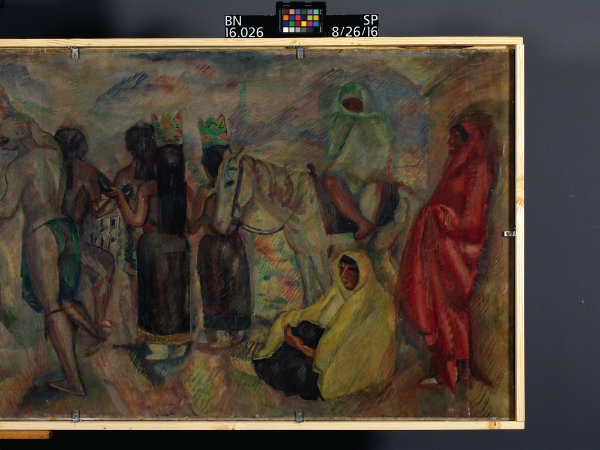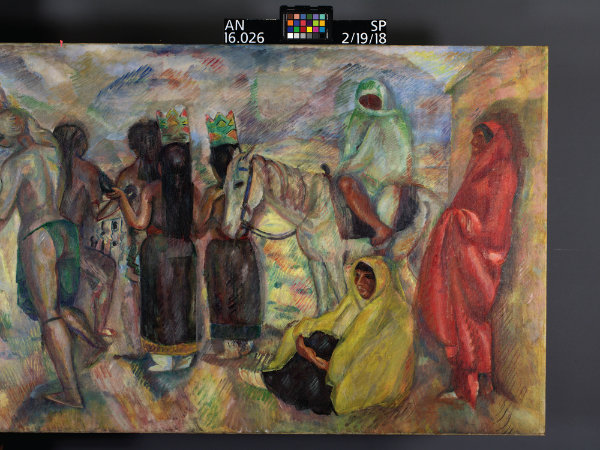Objects of a Certain Era
Meticulous conservation restores a 1912 Paul Burlin mural to its original vibrance
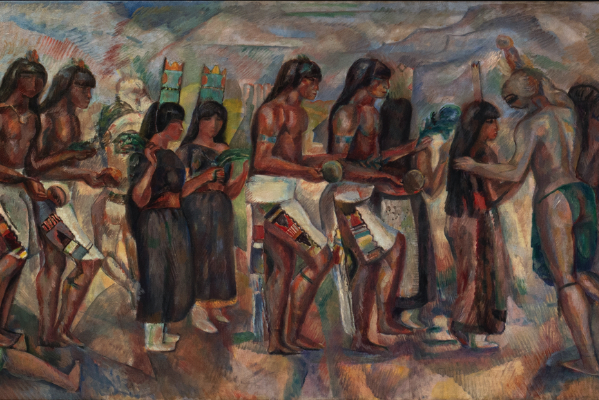 (Detail) Despite grime and glare from uneven varnish, this photograph taken before treatment shows the vibrant colors and detail waiting to be revealed in conservation. Photograph courtesy Steven Prins & Company.
(Detail) Despite grime and glare from uneven varnish, this photograph taken before treatment shows the vibrant colors and detail waiting to be revealed in conservation. Photograph courtesy Steven Prins & Company.
By Erica Prater and Christian Waguespack
In 1912, George A. and Lillian D. Harris of New York City purchased the painting Figure of a Woman by Paul Burlin (1886–1969), the earliest Modernist to work in New Mexico. This acquisition was the beginning of a years-long relationship between the extended Harris family and Burlin. Over the years, the family commissioned several paintings, amassing what former New Mexico Museum of Art Director David Turner would call “the most significant collection of Burlin’s work in the country.”
The Harrises commissioned Burlin to complete three murals for their Manhattan apartment in 1912—Stone Age, Rhapsody, and Awakening—all influenced by the artist’s 1910 visit to New Mexico. In 1921, an article from The Arts described the Harrises’ murals: “Above the paneling, which is about a tall man can reach [sic], there runs a painted frieze, about 2 feet high by Paul Burlin.” After the completion of the 1912 murals, additional paintings such as Untitled (Pelicans and Other Seabirds), and depictions of Indigenous ceremonies like Untitled (Indian Ceremonial Dance) and Untitled (Southwest Indian Scene), were commissioned by the family for their various homes. Over time, the murals and other pieces were passed down to members of the Harris family with the eventual consolidation of the artworks by George’s nephew, Edwin A. Harris Jr. In 1984, the murals were moved to the townhouse Edwin Jr. shared with his wife Frances, where they remained until Frances’s death in 2015.
In 2017, funds from the Jean and Robert L. Clarke Endowment Fund enabled the New Mexico Museum of Art to pursue its mission of conserving and caring for important works in the collection. One of Burlin’s murals, acquired by the museum in 2015, was among those preserved for generations to come.
Having been originally hung above the family fireplace, several of these murals were in need of cleaning to remove years of smoky residue in order bring their vibrant colors back to life. Santa Fe conservator Steven Prins & Company cleaned the mural, restored the colors to their former brilliance, and created a new support for the canvas. The transformation of this work from its dark and dull appearance to its original bright and brilliant colors is undeniably impressive; with its conservation, the New Mexico Museum of Art has added another historic and aesthetically thrilling jewel to its Modernist crown.
Paul Burlin: New Mexico’s First Modernist
Paul Burlin is recognized as the first artist to bring the stylistic developments of European and American Modernism, such as the expressionistic color of Fauvism, to New Mexican art. In 1910, Burlin first visited Santa Fe, and the paintings he made on this trip were displayed in New York the following year. The approbation this work received led Ashcan painter William Glackens to invite Burlin to participate in the 1913 New York Armory Show.
At only 27 years old, Burlin was the one of the youngest artists included in the exhibition. Despite his young age and the participation of Europe’s premier modern artists, Burlin made a splash at the Armory Show—a contemporary claimed that he was “the most progressive contributor” to take part. The Armory Show was financially supported by Mabel Dodge (later Mabel Dodge Luhan), who would be responsible for bringing numerous American Modernist artists to New Mexico. Though Burlin arrived in New Mexico several years before Dodge, he was later part of the artistic circle of Modernists she drew west, including the likes of Marsden Harley and Andrew Dasburg.
The Armory Show is often credited with introducing Americans to European Modernism, featuring the work of artists like Matisse, Picasso, and Cézanne. Though Burlin had already seen work by Picasso two years earlier, he was particularly struck by Cézanne. The first three murals Burlin painted for the Harris apartment, Stone Age, Rhapsody, and Awakening, were completed the year before the Armory Show and illustrate Burlin’s embrace of European Modernist aesthetics before they became more recognized across the United States. Untitled (nudes in landscape with house) recalls Cézanne in content, palette, and post-impressionist form. Cézanne regularly painted groups of nude figures relaxing in Arcadian natural scenes. Like Cézanne’s paintings of bathers, Burlin’s figures are arranged almost as if on a stage lined up in various reclining or luxuriating poses, nude or in the act of disrobing.
Picasso and Cubism were also strong formal influences for Burlin, though how exactly indebted his work was to Cubism is a point of contention. A 1921 essay on the murals Burlin painted for the Harris apartment, published in The Arts, suggests, “Although the work is not definitely Cubistic, Burlin has been influenced by Cubist art, as was Arthur B. Davis, in the room which he decorated so successfully. There is in the work of the great Florentine decorators, especially in the work of Piero della Francesca, much which is akin to the Cubist masters. Paul Burlin has felt how fitted to decorative purposes cubism is.”
The aesthetics of Cubism can certainly be seen in geometric treatment of form in several of these murals. In Stone Age and Rhapsody, we find the characteristics of flattening and distortion of forms. These characteristics can be found in Picasso’s early Cubist works. There is shallow space where the figures and background merge into one surface that is regularly fractured into various solid areas of color and texture. These Cubist formal tendencies are most pronounced in Burlin’s earlier murals, but we find subtle recurrences of these formal tendencies in his later pueblo scenes as well.
Perhaps the more important influence on Burlin was the rekindling of his interest in non-Western cultures as subject matter after seeing the European Modernism of the Armory Show. At that exhibition, Burlin was struck by the influence of so-called “primitive” art, particularly African art, on European Modernism, and wanted to find a similar inspiration in his own country. Though this interest would find its most noteworthy fulfilment in Burlin’s fascination with Pueblo dances and ceremonies in New Mexico, his painting Stone Age shows that he was already looking to prehistoric and non-Western material even before his exposure to European Modernists’ appropriation of African art.
In Stone Age, we see what could be a primordial landscape, populated with nude figures and the kind of animals one would expect to see in prehistoric cave paintings. The browns and reds of Burlin’s palette, as well as the way he poses the animals in this scene, certainly echo what we find in cave paintings, but these figures are anachronistically paired with a central figure of a Pueblo woman, wrapped in a dark shawl with a pot balanced on her head, as well of other artifacts of Puebloan pottery on the left of the painting. Burlin’s interest in Pueblo subject matter was a major recurring theme and the subject of his later murals Untitled (Southwest Indian Scene) and Untitled (Indian Ceremonial Dance).
Burlin arrived again in New Mexico in 1913 where he and his wife, ethnomusicologist Natalie Curtis, became deeply interested in the traditional cultures of the region. Burlin’s interest in Pueblo dances influenced other major American Modernists. After leaving Taos for Santa Fe, Marsden Hartley frequented Pueblo dances with Burlin and his wife during his first visit to New Mexico in 1918. This exposure led Hartley to the conclusion that Pueblo culture was the truly American subject matter he was looking for in the West and prompted him to write, “I am an American discovering America.”
For his part, Burlin and his wife often fought with Dodge over whether Indigenous ceremonies should be shown to the outside world; Burlin and Curtis believed they should be protected. Paradoxically, however, this did not stop Burlin from enthusiastically representing these ceremonies in his work. For Burlin, the dances and ceremonies of the Pueblo peoples along the Rio Grande provided that uniquely American subject matter for which he was longing.
The Harris Murals in New Mexico
Former New Mexico Museum of Art Director David Turner made a visit to New York City in 1992 and met with Edwin and Frances Harris at their Manhattan apartment to view the Harris family’s collection of Paul Burlin paintings, including seven murals. A 1994 letter from Turner mentioned how important the works were, and also stated, “As you plan for the eventual disposition of these works, especially the murals, please keep the Museum of Fine Arts, Santa Fe in mind for we would offer them an appropriate home.” Flash forward twenty-one years, when the museum received notice regarding the will of Frances Harris, bequeathing seven murals by Paul Burlin to the New Mexico Museum of Art.
In 2015, members of the museum’s collections committee were informed of the bequest. The committee was very excited to hear of this significant acquisition, and there was unanimous agreement to accept these works for the collection. This acquisition was a perfect fit with the museum’s mission; Burlin was an important artist to New Mexico, the murals have a connection to New Mexico, and the works are of great scale with a solid provenance. At the July-August 2015 Museum of New Mexico Board of Regents meeting, the murals were officially approved for acceptance into the New Mexico Museum of Art’s collection.
Since the murals were in New York at the time of acceptance, the logistics of getting them to the museum took some time. They had to be removed from the walls of the apartment, packed, and crated for travel across the country to Santa Fe. On May 13, 2016, the crate arrived at the museum. The crate measured 40 by 135 by 10 inches, and needed time to acclimate for several days before the contents were unpacked.
Collections Manager Erica Prater recalls, “Due to the size of the murals, I was unable to unpack them alone. At the time the collections department had intern Mariah Creelman working with us, who happily assisted. When we took the first mural out of the crate, we found it to be flimsy due to it being longer than tall and lacking a rigid support backing, and we had to be extra careful so as not to torque it. We worked our way through them one by one, and photographing them along the way. After Mariah and I finished unwrapping and photographing each work, we put them away for safe keeping until we could get them processed into the collection.
“Upon inspection of each of the murals, I found that they all showed their age; however, this is not surprising. Any object of a certain era that has been exposed to environmental and human hazards is going to have condition issues. For example, as in the case of the murals, they all have a layer of grime present on the painted surface, [due to] exposure to soot, nicotine, dirt, and dust, all which accumulate over time. Another common attribute of old paintings is a yellowing of the varnish, which the murals appeared to have as well. These issues resulted in a muddled palette, obscuring the vibrant colors. The support backings of the murals were cobbled together, and different materials were used for each mural, resulting in a lack of rigidity. This lack of support can cause the painting to twist quite easily, resulting in bending of the canvas and cracking of the painted surface. Another condition issue was the murals had been moved from residence to residence throughout the years, causing strain and damage to the artworks. Unfortunately, the overall condition of the murals made them unable to be exhibited until they received conservation.”
Decision to have one conserved
Since conservation treatment is time-consuming and labor-intensive, it is expensive. Budget concerns for conservation treatment of artworks are always a factor at the museum, and there are several elements to consider when deciding which object will receive treatment. The murals, though a significant acquisition, were unable to be exhibited in the state in which they were received; this prompted the decision to use available funds to have one mural undergo conservation treatment.
Head of Curatorial Affairs and Curator of Contemporary Art Merry Scully was the one to select which mural underwent treatment. With an eye towards what would be most immediately useful for upcoming exhibitions, she selected Untitled (Indian Ceremonial Dance) for its distinct New Mexican content.
Shortly after, the museum hired a new curator of twentieth-century art, Christian Waguespack. Waguespack remembers, “This was one of my first projects coming on board at the museum, and it was incredibly exciting to work with such a large and significant piece by Burlin. I still remember the excitement of visiting the painting at the conservator’s studio the first time—even dulled and dirty, it was stunning. The process just got more exciting from there. On top of the anticipation I felt revisiting the painting over the course of its treatment and getting to see the vibrant colors slowly emerging from under the grime, there were unexpected surprises! One day we found a piece of the painting which had at one point been cut off and glued to the back! We were able to see it get reattached and the painting become whole again for the first time in who knows how long. That was really special.”
Conservation
Local painting conservator Steven Prins was contacted about conserving this mural and completing an assessment. With the mural being fragile and large, the Museum of Art Chief Preparator Sam Rykels built a simple travel crate to transport the mural safely to Prins’s studio.
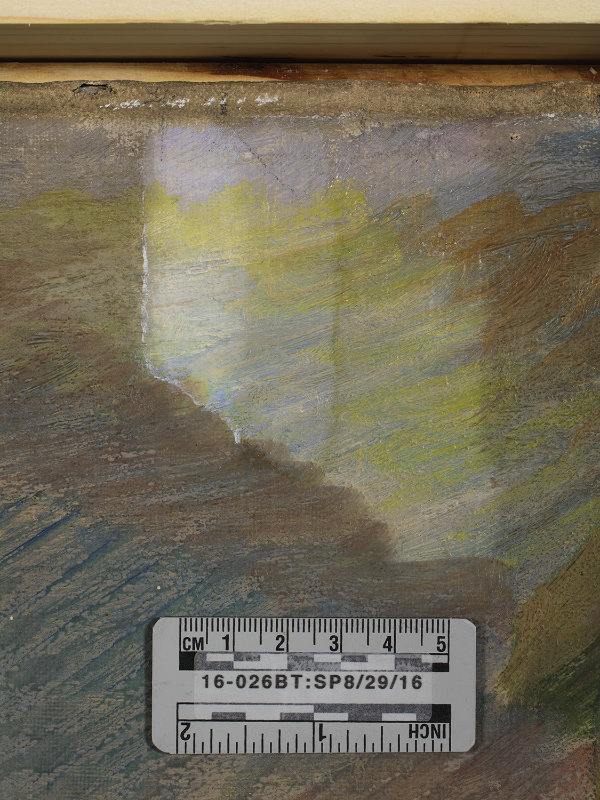
Before treatment, Prins provided a proposal to the museum detailing the scope of work required and a cost estimate. The proposal laid out in great detail the condition issues that needed addressing and how Prins proposed to treat them: “Cleaning to remove heavy accumulation of soot, grime and old discolored varnish; remounting onto a proper stretcher or more substantial panel; reduce and alleviate deformations in the canvas, including those associated with cracking, to the extent safely possible by local treatment.” The proposal was reviewed, considered, and approved by the director, thus commencing the treatment of the mural.

When Prins examined the verso of the mural, he found that a 5- to 5 ½-inch section of the original image was cut off and used as reinforcement for the two pieces of the backing. A 3-inch portion of the image was folded over on the right side and 1-inch section of the original image was cut off and used to reinforce a rupture in the paperboard backing. Prins suggested that the painting should be removed from the unidentified wall board, noting that “in spite of the fact that it appears to have adequately supported and preserved the painting for some time, the panel on which it is currently mounted is no longer deemed suitable for continued service.” It was recommended that the painting be remounted to a new secondary support that would allow for for inclusion of the folded sections and reattachment of the cut segment. Prins also conducted a little investigative work on the unidentified backing board and, with the help of a colleague, identified the original backing as Compo Board.


Addressing the dirty surface, Prins completed three spot tests to see if cleaning would be safe and effective in removing the grime. Based on the results, the painted surface could receive treatment and, much to our surprise, would require removing two layers of grime and a single layer of varnish; Prins wrote, “The appearance of the painting is seriously compromised by a heavy accretion of grime and old, discolored varnish. This occurs in three distinct layers: gray sooty grime deposited directly on the painted surface; a heavy, very irregularly applied layer of what appears to be natural resin varnish on top of that; a heavy second layer of gray, sooty grime that has accumulated on the painted surface since it was varnished.” Prins provided an image of the test-cleaned areas and the results were impressive, showing the vibrancy of colors that the painting originally had featured.
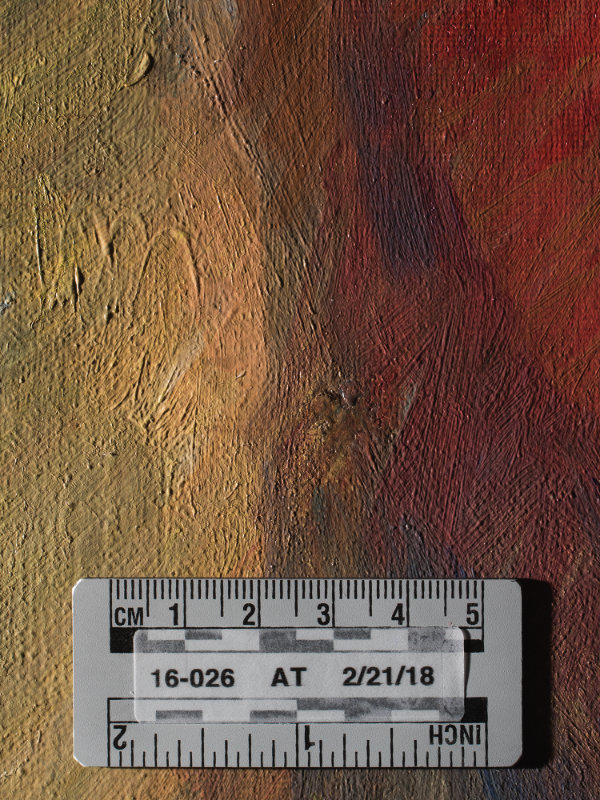
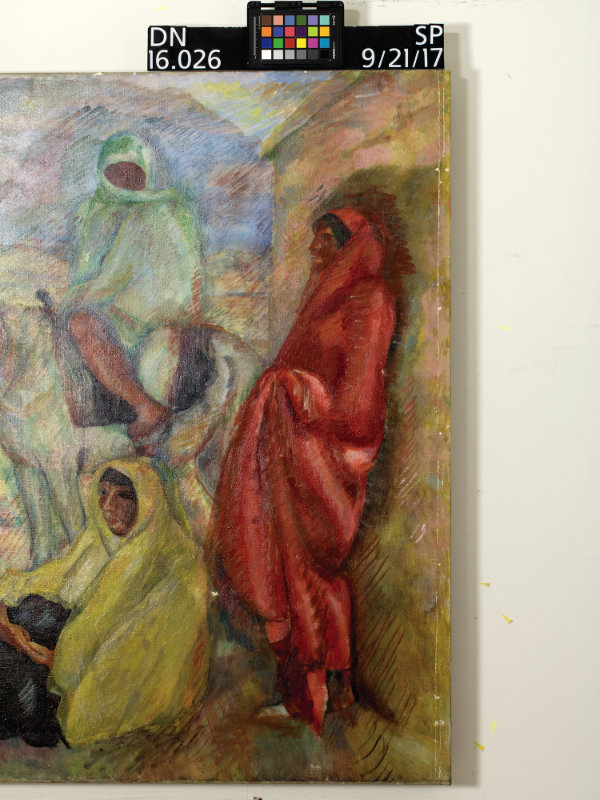
After 200-plus hours of treatment to the tune of $21,600, the mural was finished in late February 2018. “Cleaning was carried out in three phases,” Prins wrote, “in order to selectively remove three distinct layers: superficial grime, old, oxidized and discolored varnish, and underlying grime residing directly on the painted surface.” Additionally, he wrote, “treatment to reduce and alleviate cracks and other deformations in the canvas were carried out; while still mounted in the oversized working stretcher the reattachment of the detached fragment was finalized; filling and inpainting were carried out as necessary to compensate for damage and loss of original paint and ground.”
At this point, Untitled (Indian Ceremonial Dance) was ready to be returned to the museum. The painting was shown for the first time in Bringing Together: Recent Acquisitions in 2019–2020. Currently, the painting is on display in the Governor’s Mansion, hanging above the credenza in the dining room.
How you can help
We have seen some truly stunning results for the conservation of Untitled (Indian Ceremonial Dance), but there is still a long way to go before all of these murals are restored to their former glory. We have secured half the funds for the conservation of Stone Age through generous gifts from Susan Johnson and Kathy Jones (members of the Harris family), but we are actively seeking donors interested in assisting in the conservation of this important mural cycle.
Any inquiries regarding the murals and their conservation may be directed to either Dr. Mark White, executive director of the New Mexico Museum of Art, or the authors of this article.
Additionally, Paul Burlin’s other murals not featured in this article are available to view at the Museum of Art’s searchable art museum at sam.nmartmuseum.org.
—
Christian Waguespack has served as curator of twentieth-century art at the New Mexico Museum of Art for more than three years, where he has organized over a dozen exhibitions on New Mexican art and culture.
Erica Prater has served as collections manager at the New Mexico Museum of Art for more than seven years, where she has overseen the care and safety of the museum’s collection.




